Flash Flood Susceptibility Assessment Based on Morphometric Aspects and Hydrological Approaches in the Pai River Basin, Mae Hong Son, Thailand
Abstract
1. Introduction
2. Study Area
3. Materials and Methods
3.1. Methods
3.1.1. Quantitative Analysis of Morphometric Parameters
3.1.2. Unit hydrograph Analysis
3.1.3. Soil Conservation Service Curve Number Method
3.1.4. Local Calibration the Satellite Rainfall
3.1.5. Ranking of All Parameters for the Categorized the Sub-Watershed
3.2. Data
4. Results and Discussion
4.1. Sub-Watersheds and Their Morphometric Parameters
4.1.1. Linear Features Group
4.1.2. Areal Features Group
4.1.3. Relief Features Group
4.2. Calibration of Rainfall
4.3. Unit Hydrograph Analysis
4.4. Total Watershed Runoff
4.5. Flash Flood Susceptibility Mapping
5. Conclusions
Funding
Institutional Review Board Statement
Informed Consent Statement
Data Availability Statement
Acknowledgments
Conflicts of Interest
References
- Chantip, S.; Marjang, N.; Pongput, K. Development of dynamic flash flood hazard index (DFFHI) in Wang river basin, Thailand. In Proceedings of the 22nd IAHR-APD Congress 2020, Sapporo, Japan, 15–16 September 2020. [Google Scholar]
- Quesada-Román, A. Flood risk index development at the municipal level in Costa Rica: A methodological framework. Environ. Sci. Policy 2022, 133, 98–106. [Google Scholar] [CrossRef]
- Bhaskar, N.R.; French, M.N.; Kyiamah, G.K. Characterization of flash flood in eastern Kentucky. J. Hydrol. Eng. 2000, 5, 3237–3331. [Google Scholar] [CrossRef]
- Wu, J.; Liu, H.; Wei, G.; Fu, G.; Markus, M.; Ye, L.; Zhang, C.; Zhou, H. Flash flood peak estimation in small mountainous catchment based on distributed geomorphological unit hydrographs using Fuzzy C-means Clustering. J. Hydrol. Eng. 2020, 25, 04020051. [Google Scholar] [CrossRef]
- Kim, B.-S.; Kim, H.-S. Evaluation of flash flood severity in Korea using the modified flash flood index (MFFI). J. Flood Risk Manag. 2014, 7, 344–356. [Google Scholar] [CrossRef]
- Koutroulis, A.G.; Tsanis, I.K. A method for estimating flash flood peak discharge in a poorly gauged basin: Case study for the 13-14 January 1994 flood, Giofiros basin, Crete, Greece. J. Hydrol. 2010, 385, 150–164. [Google Scholar] [CrossRef]
- Quesada-Román, A.; Ballesteros-Cánovas, J.A.; Granados-Balaños, S.; Birkel, C.; Stoffel, M. Improving regional flood risk assessment using flood frequency and dendrogeomorphic analyses in mountain catchments impacts by tropical cyclones. Geomorphology 2022, 396, 108000. [Google Scholar] [CrossRef]
- Ahn, K.-H.; Merwade, V. Role of watershed geomorphic characteristics on flooding in Indiana, United States. J. Hydrol. Eng. 2016, 21, 05015021. [Google Scholar] [CrossRef]
- Kocsis, I.; Bilașco, Ș.; Irimuș, I.-A.; Dohotar, V.; Rusu, R.; Roșca, S. Flash flood vulnerability mapping based on FFPI using gis spatial analysis case study: Valea Rea catchment area, Romania. Sensors 2022, 22, 3573. [Google Scholar] [CrossRef]
- Shehata, M.; Mizunaga, H. Flash flood risk assessment for Kyushu Island, Japan. Environ. Earth Sci. 2018, 77, 76. [Google Scholar] [CrossRef]
- Ikirri, M.; Faik, F.; Echogadali, F.Z.; Antunes, I.M.H.R.; Abioui, M.; Abdelrahman, K.; Fnais, M.S.; Wanaim, A.; Id-Belqas, M.; Boutaleb, S.; et al. Flood hazard index application in arid catchment: Case of the Taguenit Wadi watershed, Lakhssas, Morocco. Land 2022, 11, 1178. [Google Scholar] [CrossRef]
- Yoo, C.; Lee, J.; Chang, K. Sensitivity evaluation of the flash flood warning system introduced to ungauged small mountainous basins in Korea. J. Mt. Sci. 2019, 16, 971–990. [Google Scholar] [CrossRef]
- Alam, A.; Ahmed, B.; Sammonds, P. Flash flood susceptibility assessment using the parameters of drainage basin morphometry in SE Bangladesh. Quat. Int. 2021, 575–576, 295–307. [Google Scholar] [CrossRef]
- Sharma, T.P.P.; Zhang, J.; Khanal, N.R.; Prodhan, F.A.; Nanzad, L.; Zhang, D.; Nepal, P. A geomorphic approach for identifying flash flood potential areas in the East Rapti River Basin of Nepal. ISPRS Int. J. Geo-Inf. 2021, 10, 247. [Google Scholar] [CrossRef]
- Abdelkader, M.M.; Al-Amoud, A.I.; El Alfy, M.; El-Feky, A.; Saber, M. Assessment of flash flood hazard based on morphometric aspects and rainfall-runoff modeling in Wadi Nisah, central Saudi Arabia. Remote Sens. Appl. Soc. Environ. 2021, 23, 100562. [Google Scholar] [CrossRef]
- Abdel-Fattah, M.; Saber, M.; Kantoush, S.A.; Khalil, M.F.; Sumi, T.; Sefelnasr, A.M. A hydrological and geomorphometric approach to understanding the generation of Wadi flash floods. Water 2017, 9, 553. [Google Scholar] [CrossRef]
- Mishra, A.; Coulibaly, P. Developments in hydrometric network design: A review. Rev. Geophys. 2009, 47, 1–24. [Google Scholar] [CrossRef]
- Watters, D.; Battaglia, A. The NASA-JAXA global precipitation measurement mission—Part I: New frontiers in precipitation. Weather 2021, 76, 41–44. [Google Scholar] [CrossRef]
- Funk, C.; Peterson, P.; Landsfeld, M.; Pedreros, D.; Verdin, J.; Shukla, S.; Husak, G.; Rowland, J.; Harrison, L.; Hoell, A.; et al. The climate hazards infrared precipitation with stations-a new environment record for monitoring extremes. Sci. Data 2015, 2. [Google Scholar] [CrossRef]
- Nguyen, P.; Ombadi, M.; Sorooshian, S.; Hsu, K.; AghaKouchak, A.; Braithwaite, D.; Ashouri, H.; Thorstensen, A.R. The PERSIANN family of global satellite precipitation data: A review and evaluation of products. Hydrol. Earth Syst. Sci. 2018, 22, 5801–5816. [Google Scholar] [CrossRef]
- Chaithong, T.; Komori, D. Application of satellite precipitation data to model the extreme rainfall-induced landslide event. In Proceedings of the 22nd IAHR-APD Congress 2020, Sapporo, Japan, 15–16 September 2020. [Google Scholar]
- Ma, M.; Wang, H.; Jia, P.; Tang, G.; Wang, D.; Ma, Z.; Yan, H. Application of GPM-IMERG products in Flash flood warning: A case study in Yunnan, China. Remote Sens. 2020, 12, 1954. [Google Scholar] [CrossRef]
- Chiang, Y.M.; Hsu, K.L.; Chang, F.J.; Hong, Y.; Sorooshian, S. Merging multiple precipitation sources for flash flood forecasting. J. Hydrol. 2007, 340, 183–196. [Google Scholar] [CrossRef]
- Coning, E.D. Optimizing satellite-based precipitation estimation for nowcasting of rainfall and flash flood events over the South African domain. Remote Sens. 2013, 5, 5702–5724. [Google Scholar] [CrossRef]
- Nash, J.E. The form of the instantaneous unit hydrograph. Int. Assoc. Hydrol. Sci. 1957, 45, 114–121. [Google Scholar]
- Ross, C.W.; Prihodko, L.; Anchang, J.; Kumar, S.; Ji, W.; Hanan, N.P. HYSOGs250m, global gridded hydrologic soil groups for curve-number-based runoff modeling. Sci. Data 2018, 5, 180091. [Google Scholar] [CrossRef]
- Office of the National Water Resources. 22 Basins in Thailand; Office of the National Water Resources: Bangkok, Thailand, 2021.
- Strahler, A.N. Quantitative analysis of watershed geomorphology. Trans. Am. Geophys. Union 1957, 38, 913–920. [Google Scholar] [CrossRef]
- Horton, R.E. Erosional development of streams and their drainage basins: Hydro-physical approach to quantitative morphology. Geol. Soc. Am. Bull. 1945, 56, 275–370. [Google Scholar] [CrossRef]
- Paliaga, G.; Faccini, F.; Luino, F.; Turconi, L. A spatial multicriteria prioritizing approach for geo-hydrological risk mitigation planning in small and densely urbanized Mediterranean basins. Nat. Hazards Earth Syst. Sci. 2019, 19, 53–69. [Google Scholar] [CrossRef]
- Melton, M.A. An Analysis of the Relations Among Elements of Climate, Surface Properties, and Geomorphology; Technical Report No.11; Office of Naval Research, Department of Geology, Columbia University: New York, NY, USA, 1957. [Google Scholar]
- Faniran, A. The index of drainage intensity—A provisional new drainage factor. Aust. J. Sci. 1986, 31, 326–330. [Google Scholar]
- Schumm, S.A. Evolution of drainage systems and slopes in Badlands at Perth Amboy, New Jersey. Bull. Geol. Soc. Am. 1958, 67, 597–646. [Google Scholar] [CrossRef]
- Horton, R.E. Drainage-basin characteristics. Trans. Am. Geophys. Union 1932, 13, 350–361. [Google Scholar] [CrossRef]
- Smith, K.G. Standards for grading texture of erosional topography. Am. J. Sci. 1950, 248, 655–668. [Google Scholar] [CrossRef]
- Chorley, R.J.; Malm, D.E.G.; Pogorzelski, H.A. A new standard for estimating drainage basin shape. Am. J. Sci. 1957, 255, 138–141. [Google Scholar] [CrossRef]
- Rodriguez-Iturbe, I.; Valdes, J.B. The geomorphologic structure of hydrologic response. Water Resour. Res. 1979, 15, 1409–1420. [Google Scholar] [CrossRef]
- Prasad, R.N.; Pani, P. Geo-hydrological analysis and sub watershed prioritization for flash flood risk using weight sum model and Snyder’s synthetic unit hydrograph. Model. Earth Syst. Environ. 2017, 3, 1491–1502. [Google Scholar] [CrossRef]
- Tuntiteerawit, T.; Taesombut, V. Unit hydrograph analysis for small watershed in the northern part of Thailand. In Proceedings of the 26th Kasetsart University Annual Conference, Bangkok, Thailand, 3–5 February 1988. [Google Scholar]
- White, D. Grid-based application of runoff curve numbers. J. Water Resour. Plan. Manag. 1988, 114, 601–612. [Google Scholar] [CrossRef]
- Mishra, S.K.; Singh, V.P. Soil Conservation Service Curve Number (SCS-CN) Methodology; Springer: Dordrecht, The Netherlands, 2003. [Google Scholar]
- Paudel, M.; Nelson, E.J.; Scharffenberg, W. Comparison of lumped and quasi-distributed Clark runoff models using the SCS Curve Number equation. J. Hydrol. Eng. 2009, 14, 1098–1106. [Google Scholar] [CrossRef]
- USDA-NRCS. Chapter 10 Estimation of direct runoff from storm rainfall. In Part 630 Hydrology: National Engineering Handbook; Natural Resources Conservation Service, United States Department of Agriculture: Washington, DC, USA, 2004. [Google Scholar]
- Dembẻlẻ, M.; Zwart, S.J. Evaluation and comparison of satellite-based rainfall products in Burkina Faso, West Africa. Int. J. Remote Sens. 2016, 37, 3995–4014. [Google Scholar] [CrossRef]
- Adnan, M.S.G.; Dewan, A.; Zannat, K.E.; Abdullah, A.Y.M. The use of watershed geomorphic data in flash flood susceptibility zoning: A case study of the Karnaphuli and Sanga river basins of Bangladesh. Nat. Hazards 2019, 99, 425–448. [Google Scholar] [CrossRef]
- Mahmood, S.; Rahman, A. Flash flood susceptibility modeling using geo-morphometric and hydrological approaches in Panjkora Basin, Eastern Hindu Kush, Pakistan. Environ. Earth Sci. 2019, 78, 43. [Google Scholar] [CrossRef]
- Prabhakar, A.K.; Singh, K.K.; Lohani, A.K.; Chandniha, S.K. Study of Champua watershed for management of resources by using morphometric analysis and satellite imagery. Appl. Water Sci. 2019, 9, 127. [Google Scholar] [CrossRef]
- Obeidat, M.; Awawdeh, M.; Al-Hantouli, F. Morphometric analysis and prioritisation of watersheds for flood risk management in Wadi Easal Basin (WEB), Jordan, using geospatial technologies. J. Flood Risk Manag. 2021, 14, e12711. [Google Scholar] [CrossRef]
- Choudhari, P.P.; Nigam, G.K.; Singh, S.K.; Thakur, S. Morphometric based prioritization of watershed for groundwater potential of Mula river basin, Maharashtra, India. Geol. Ecol. Landsc. 2018, 2, 256–267. [Google Scholar] [CrossRef]
- Abdo, H.G. Evolving a total-evaluation map of flash flood hazard for hydro-prioritization based on geohydromorphometric parameters and GIS-ES manner in Al-Hussain River basin, Tartous, Syria. Nat. Hazards 2020, 104, 681–703. [Google Scholar] [CrossRef]
- Alqahtani, F.; Qaddah, A.A. GIS digital mapping of flood hazard in Jeddah-Makkah region from morphometric analysis. Arab. J. Geosci. 2019, 12, 199. [Google Scholar] [CrossRef]
- Ogerekpe, N.M.; Obio, E.A.; Tenebe, I.T.; Emenike, P.C.; Nnaji, C. Flood vulnerability assessment of the upper Cross River basin using morphometric analysis. Geomat. Nat. Hazards Risk 2020, 11, 1378–1403. [Google Scholar] [CrossRef]
- Quesada-Román, A.; Villalobos-Chacón, A. Flash flood impacts of Hurricane Otto and hydrometeorological risk mapping in Costa Rica. Dan. J. Geogr. 2020, 120, 142–155. [Google Scholar] [CrossRef]
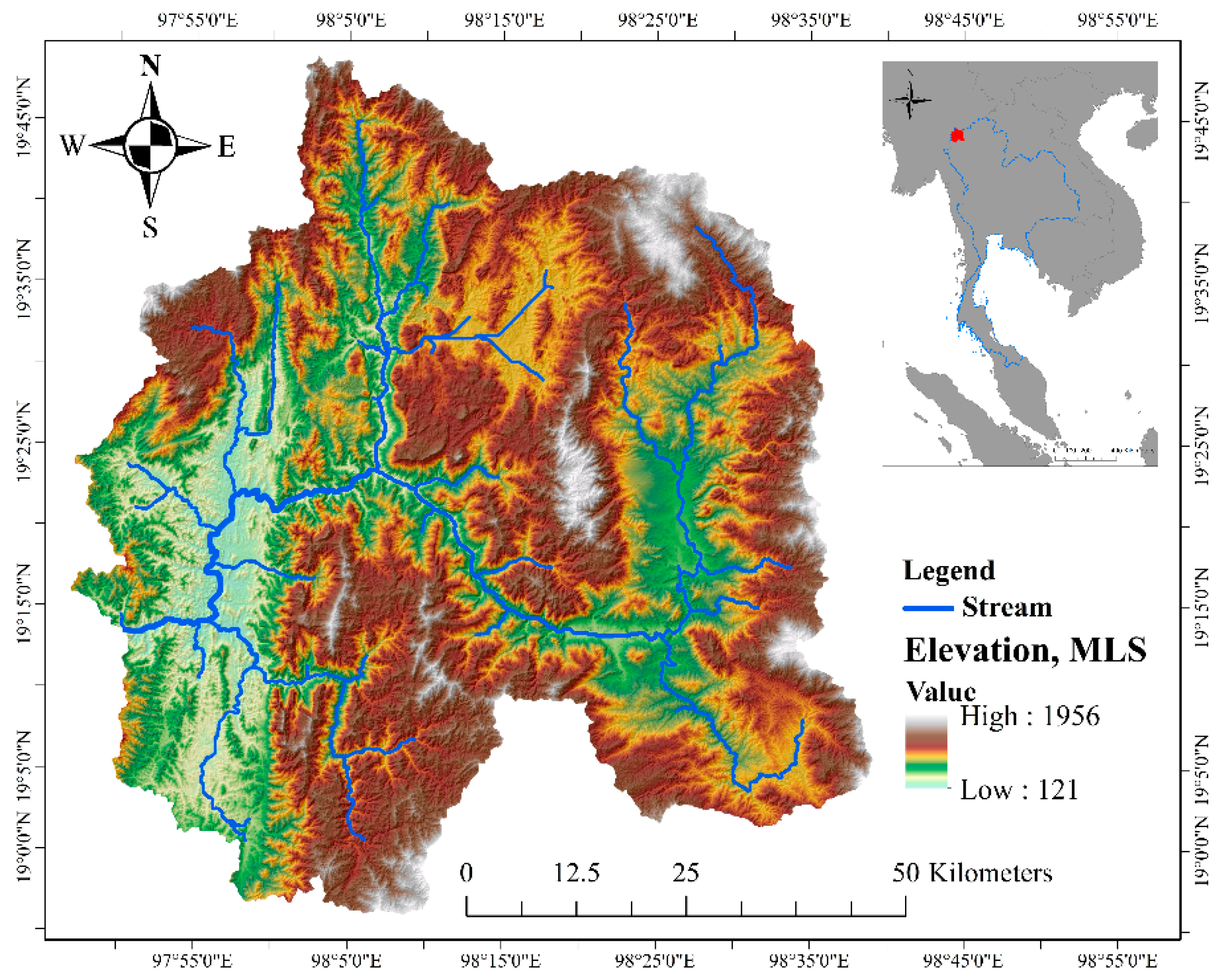
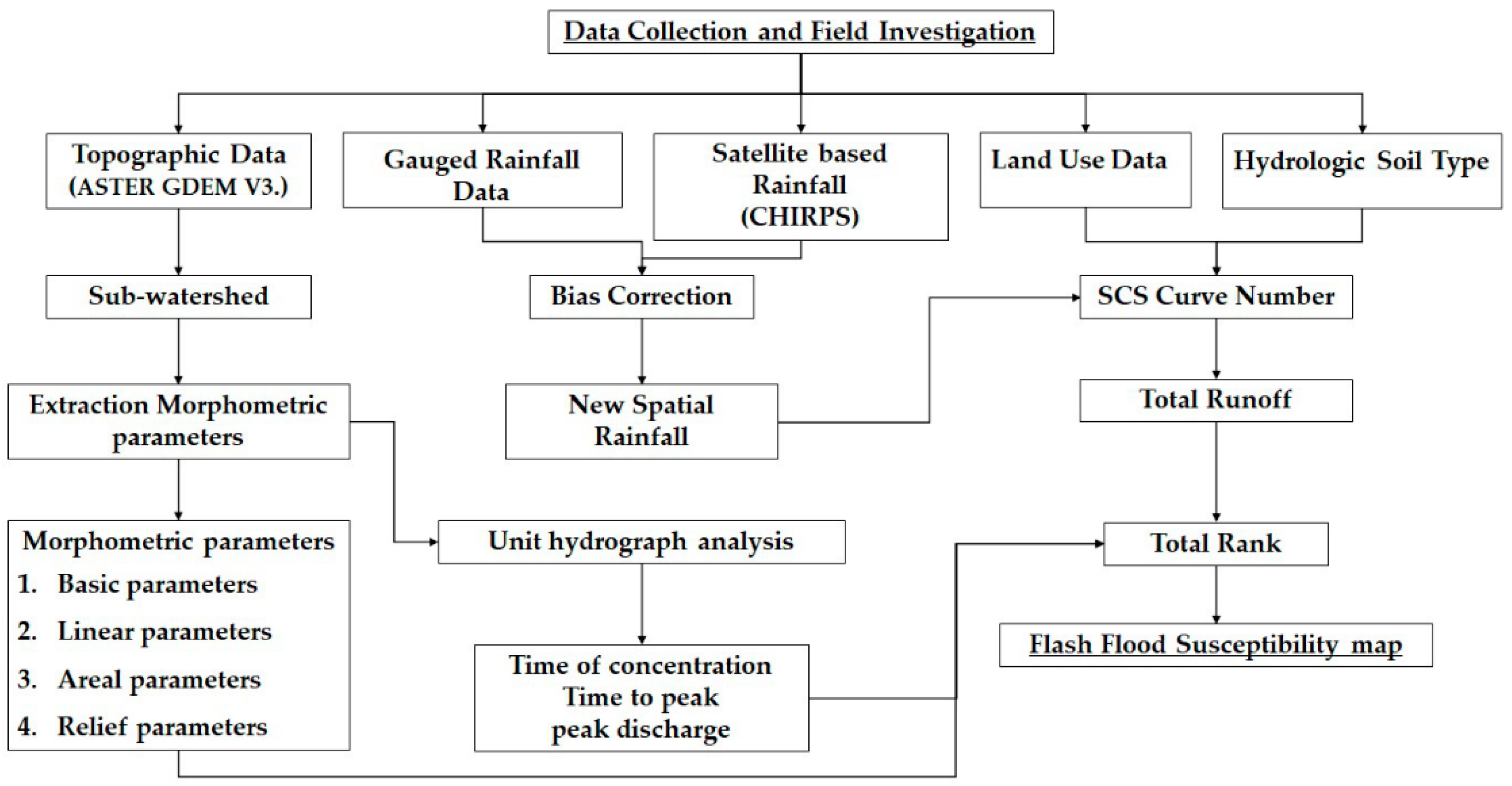

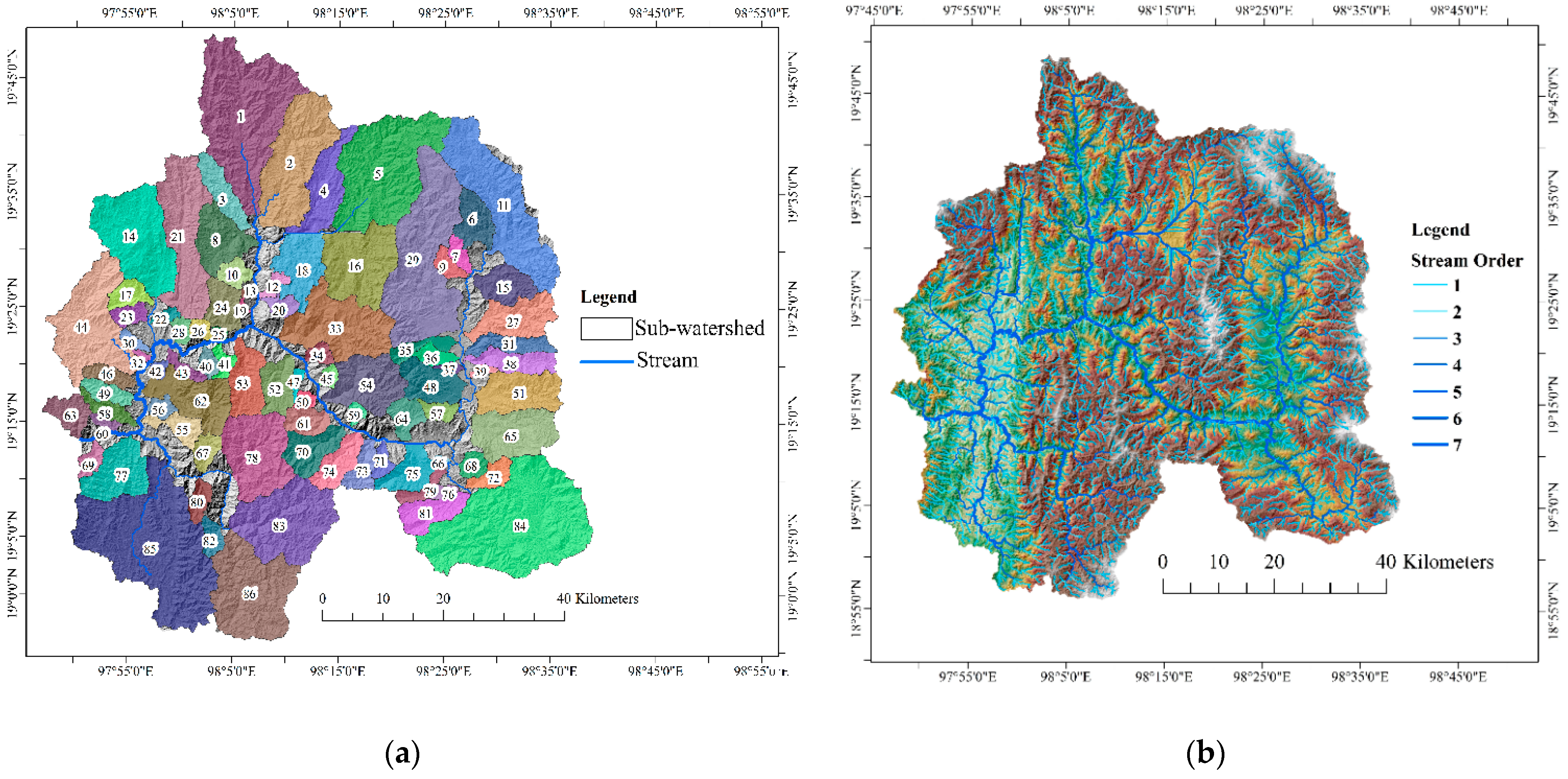
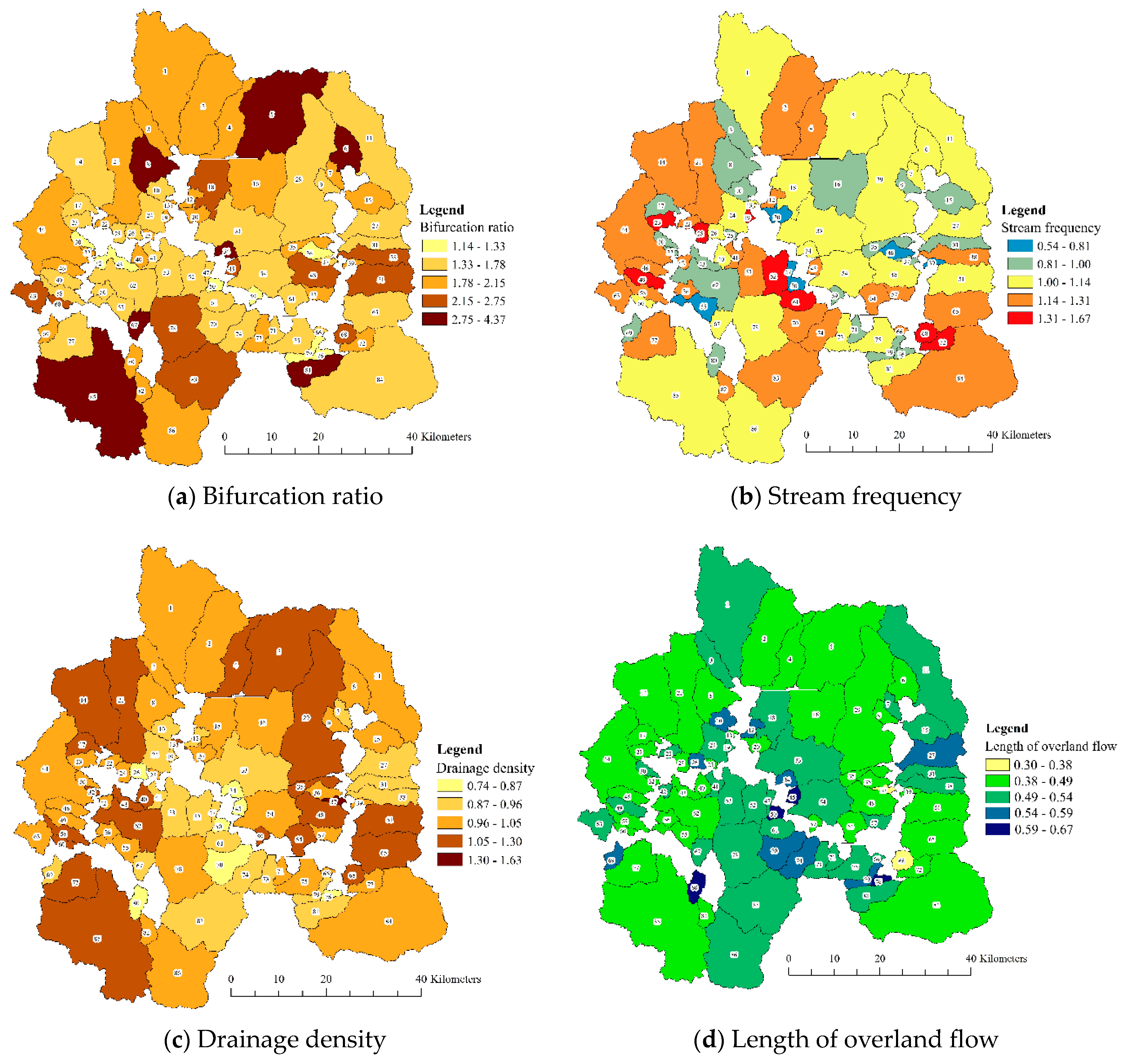

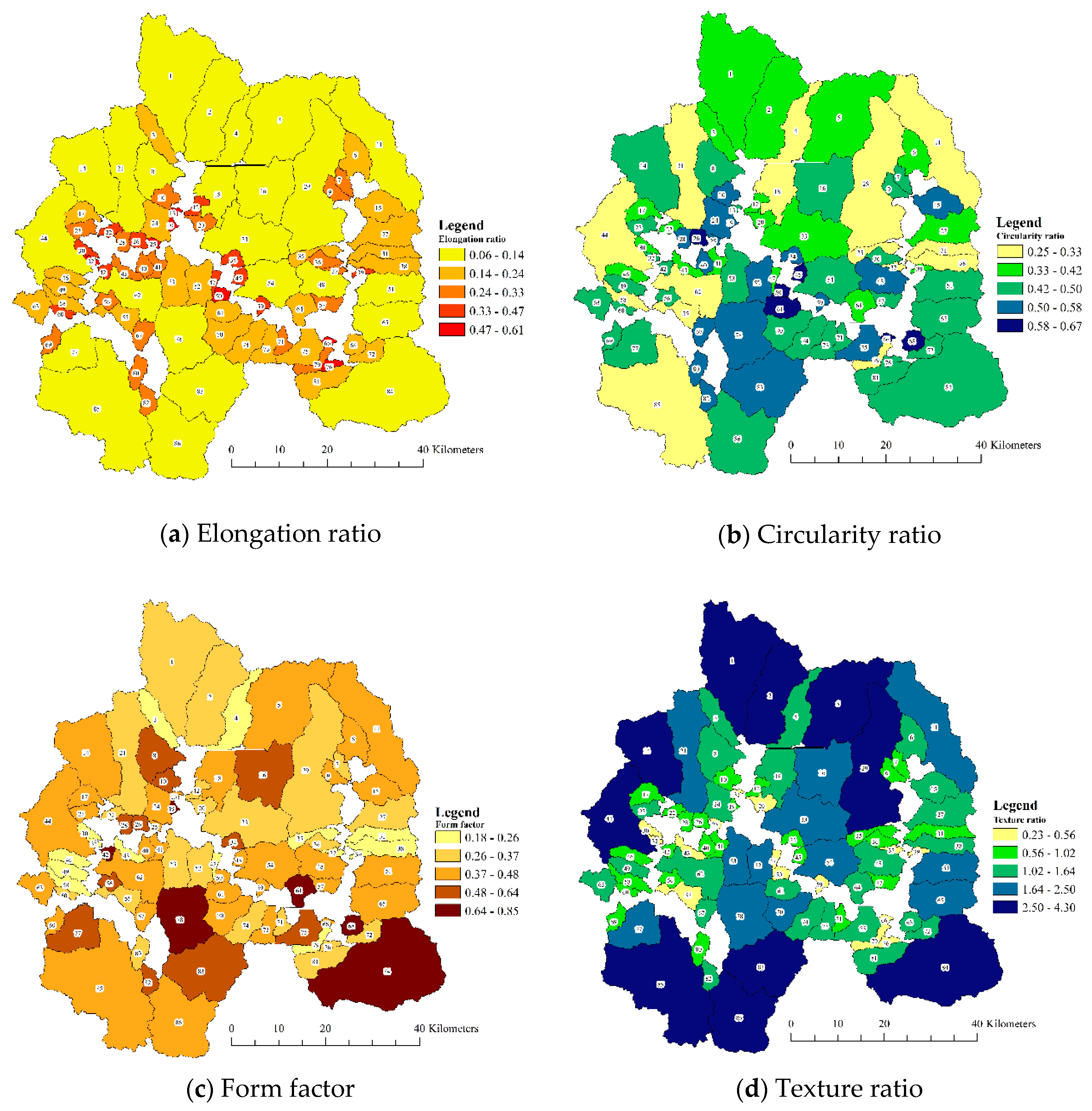
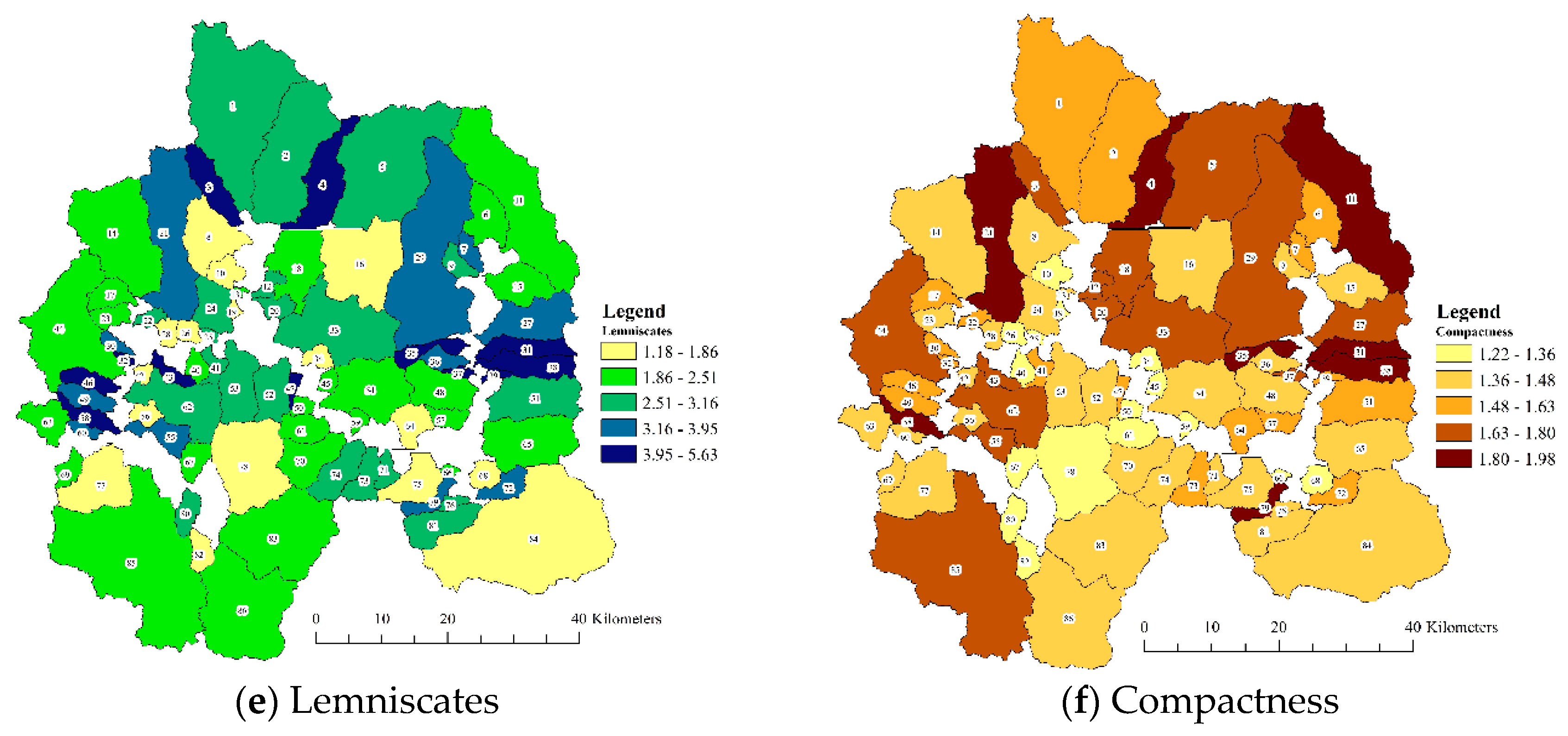



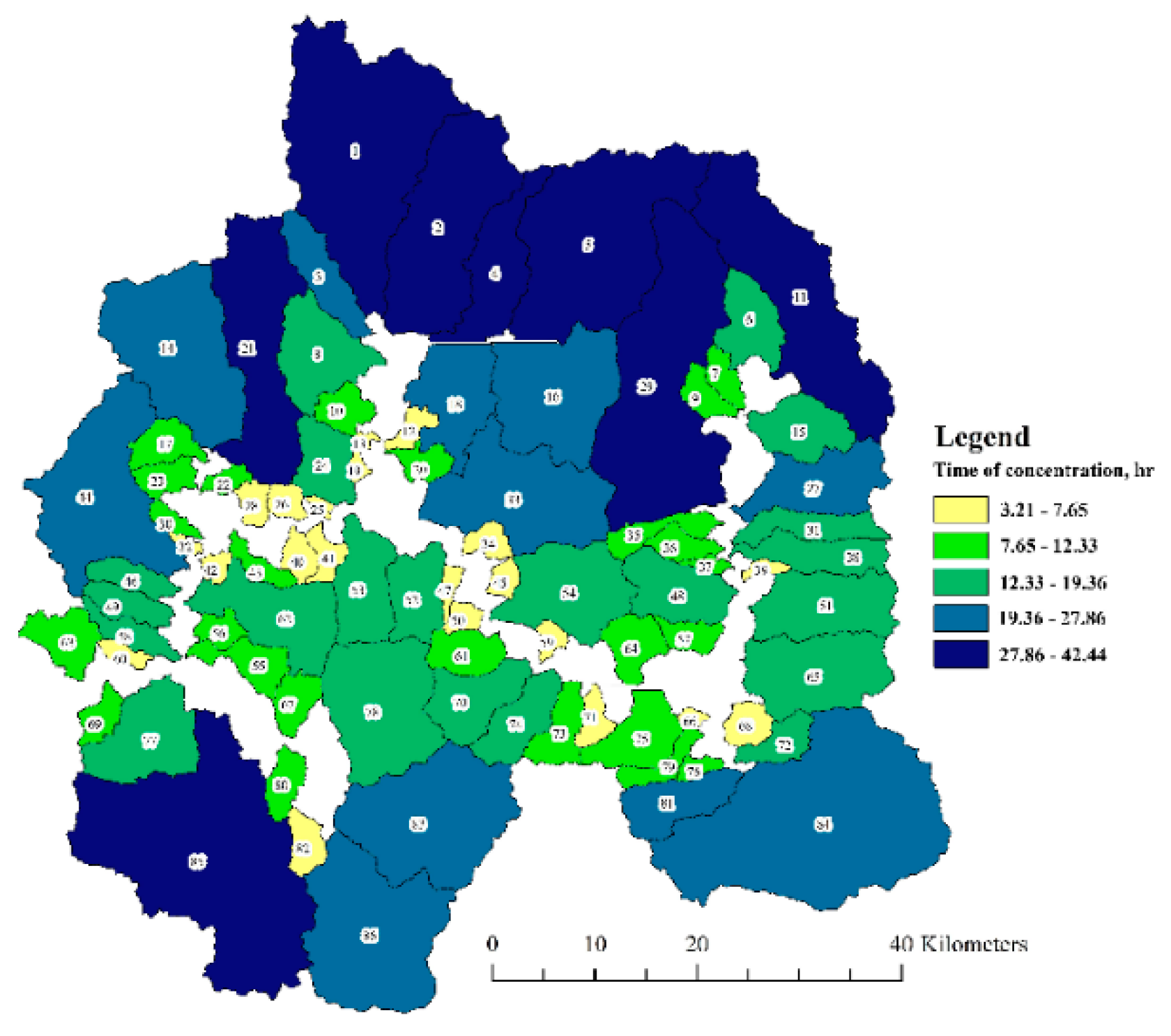
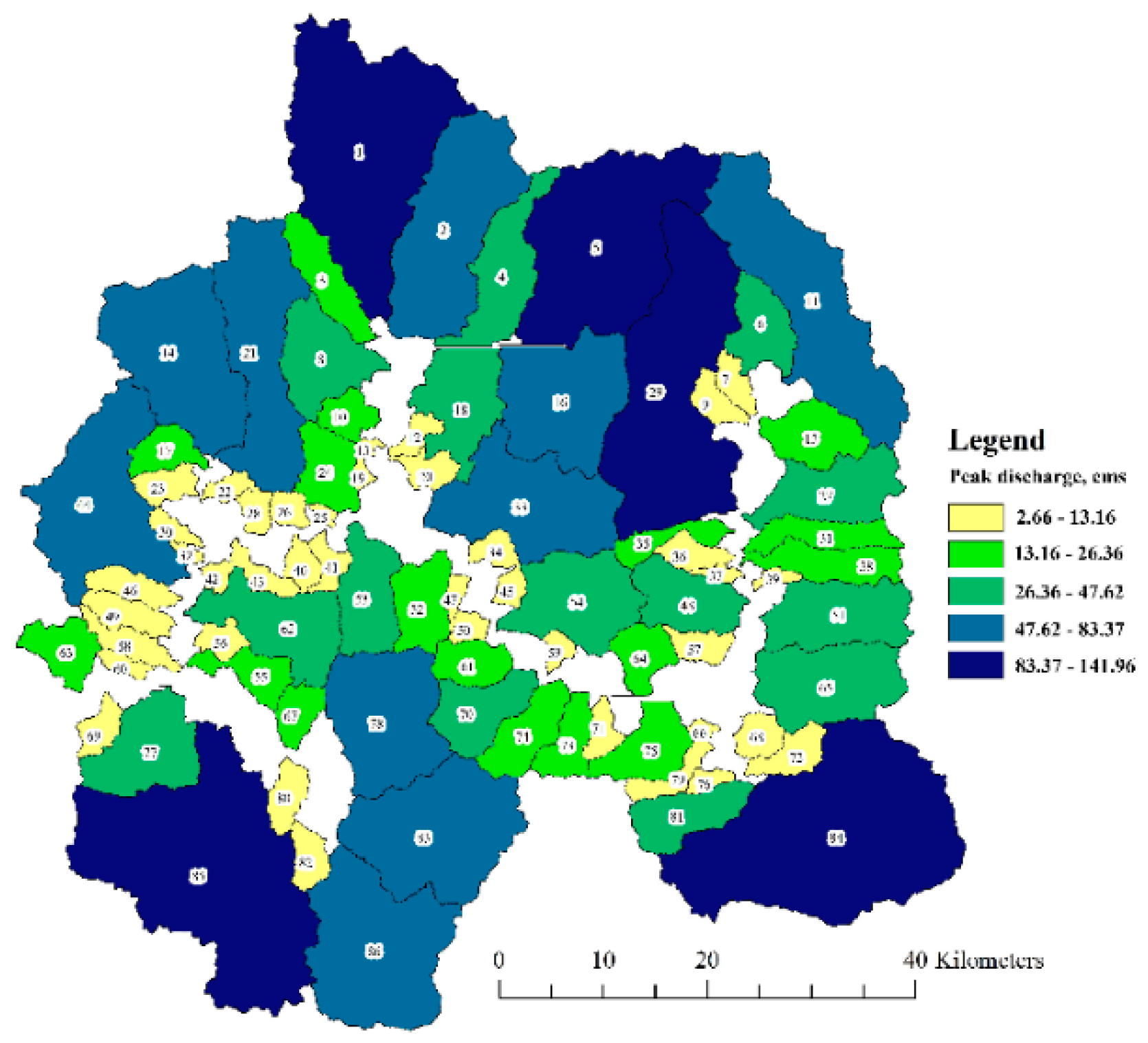
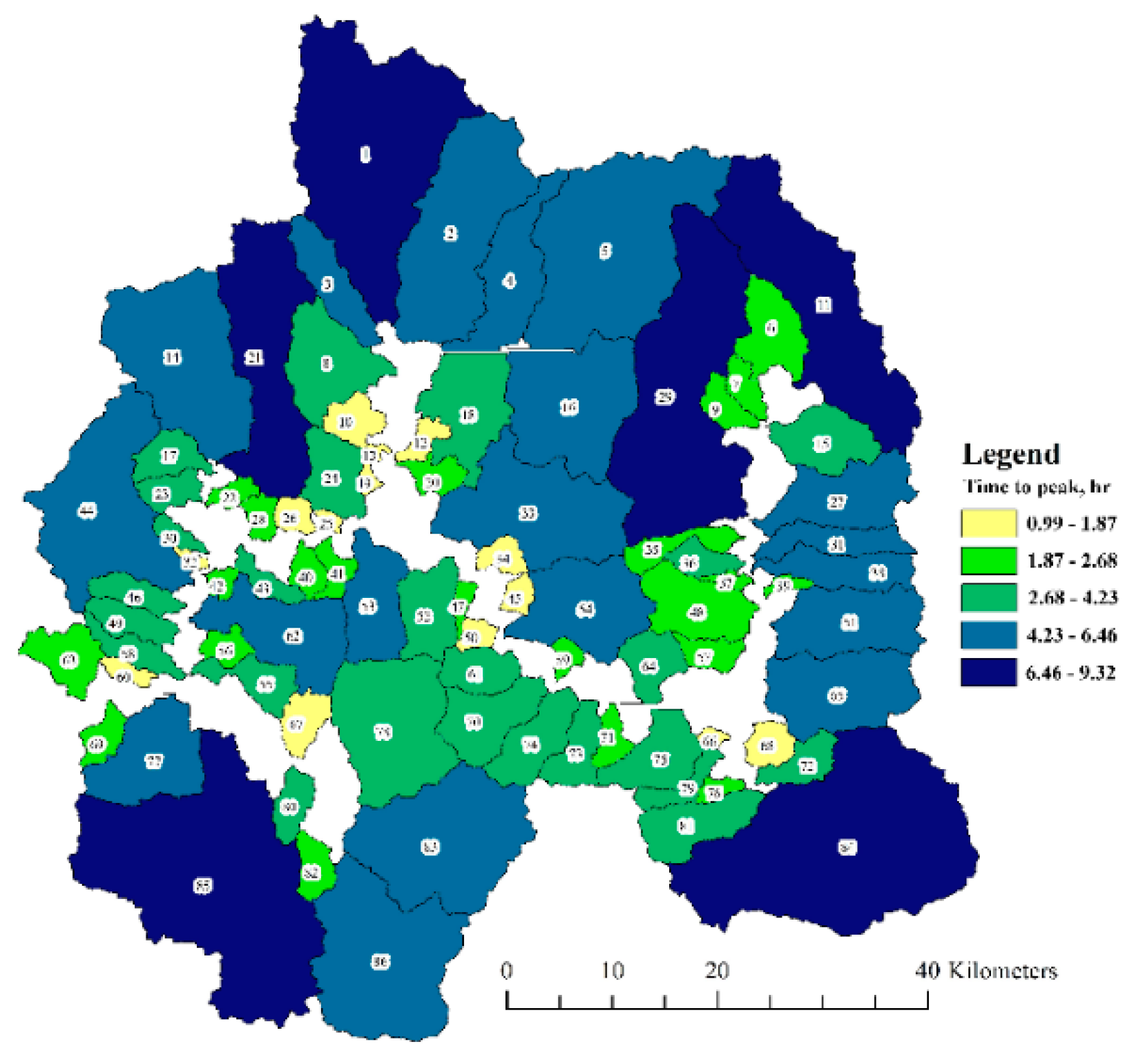
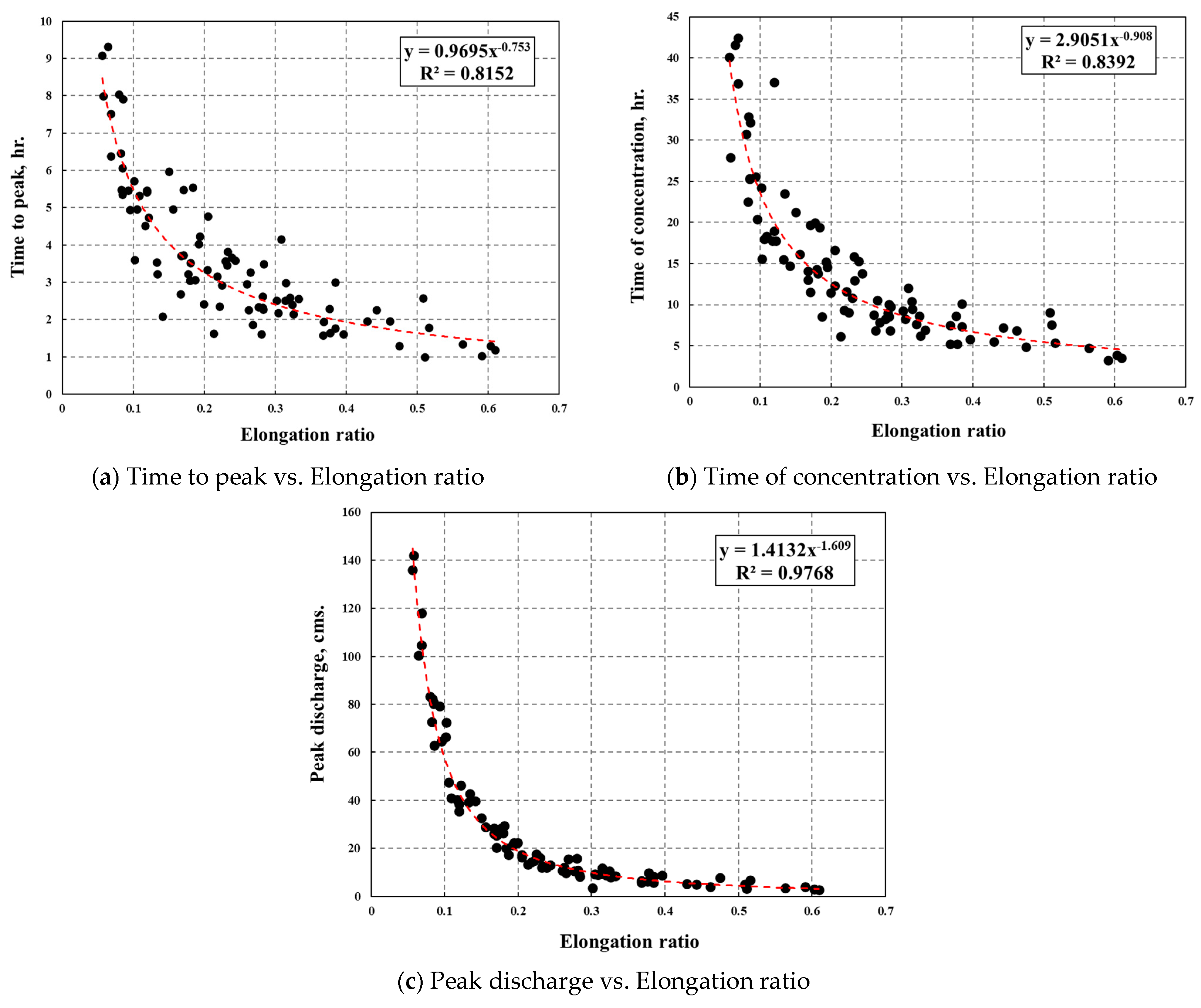
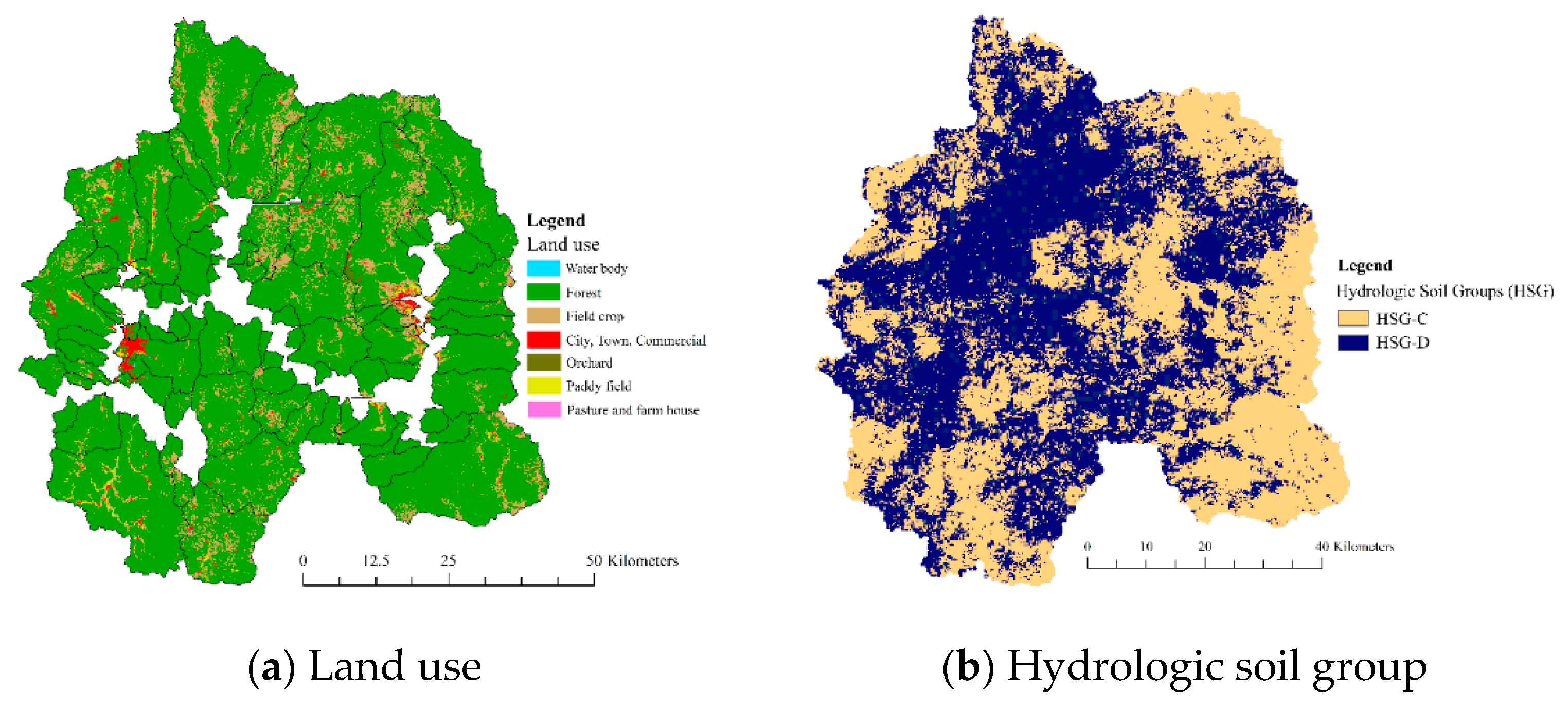
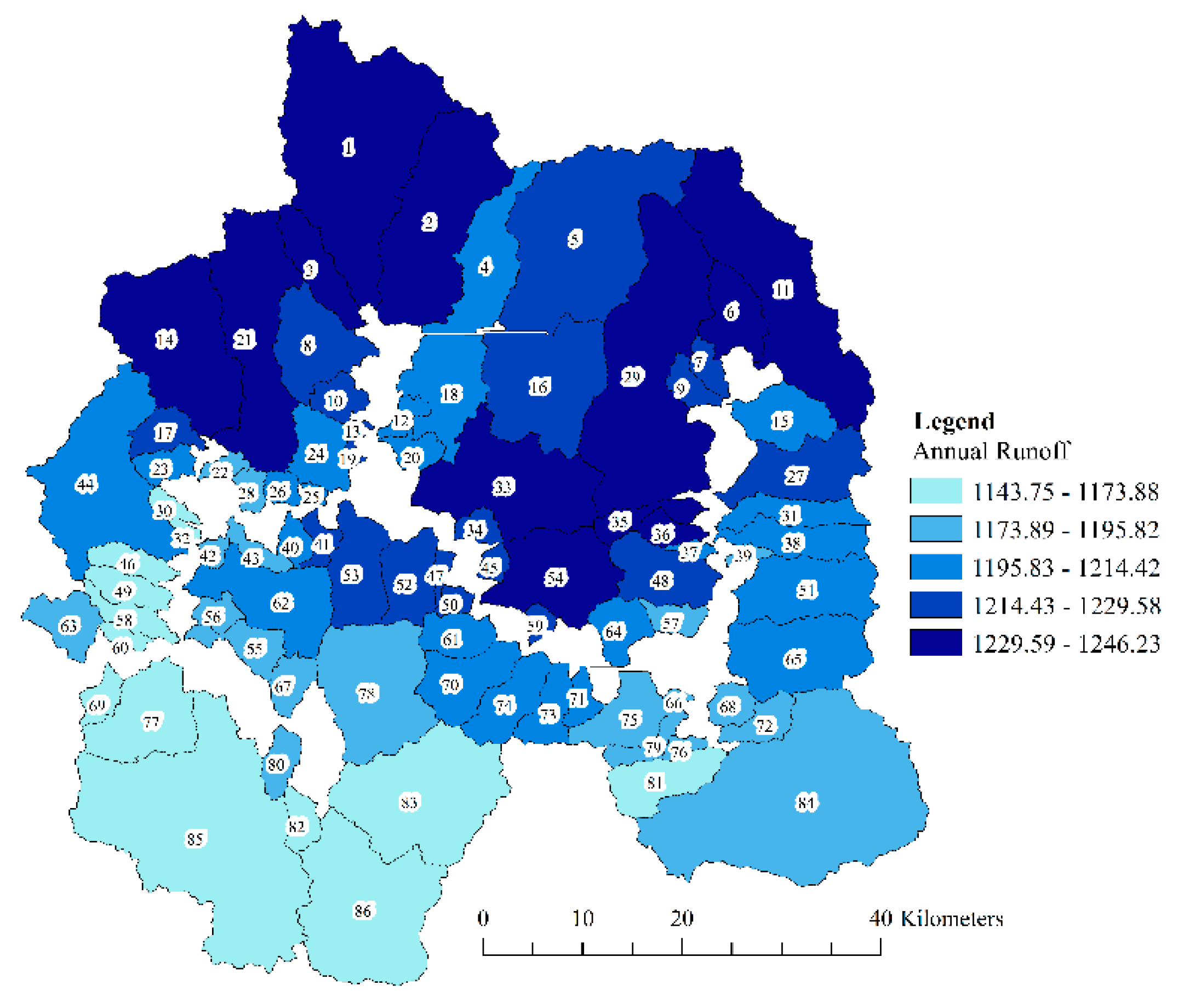
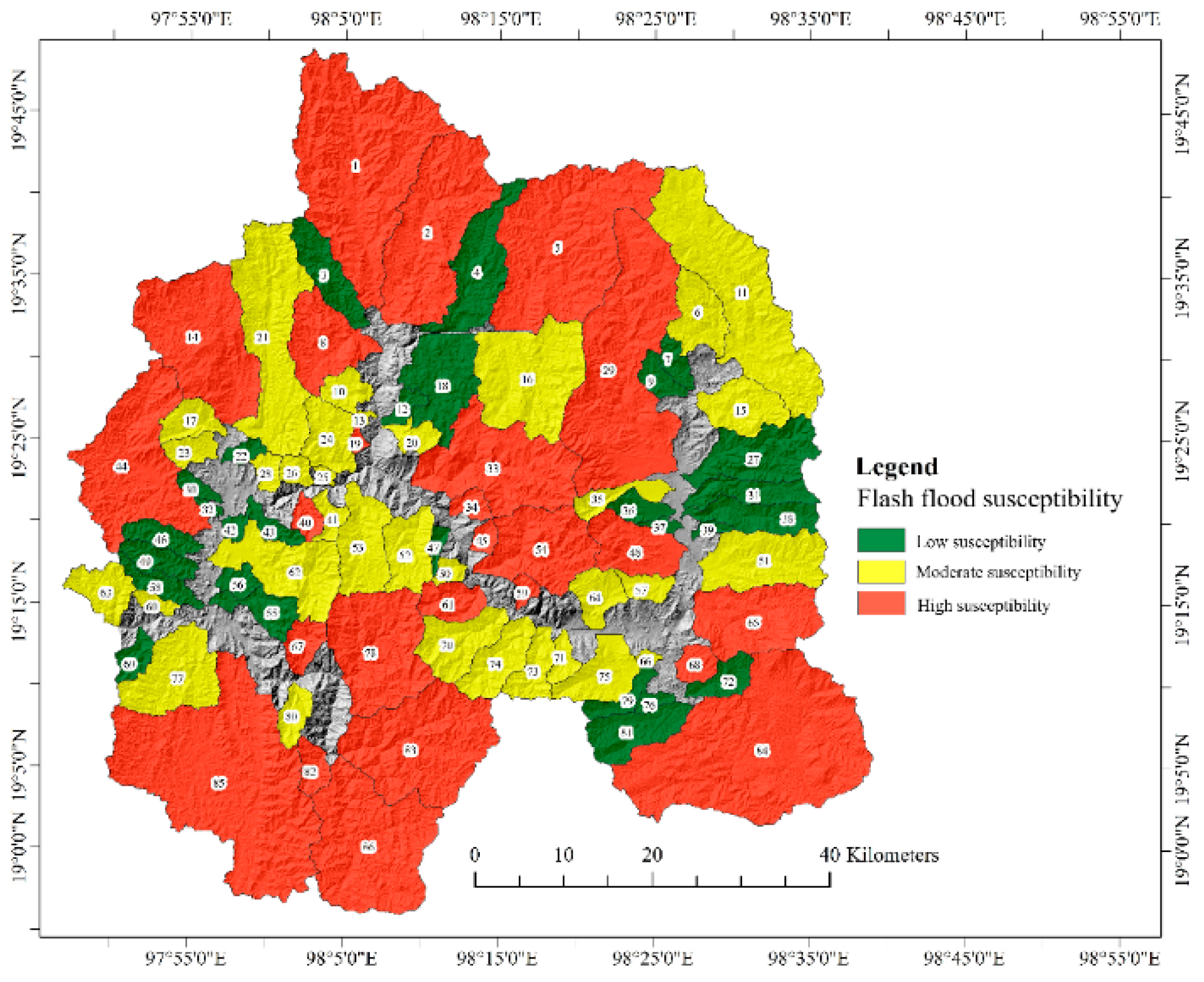
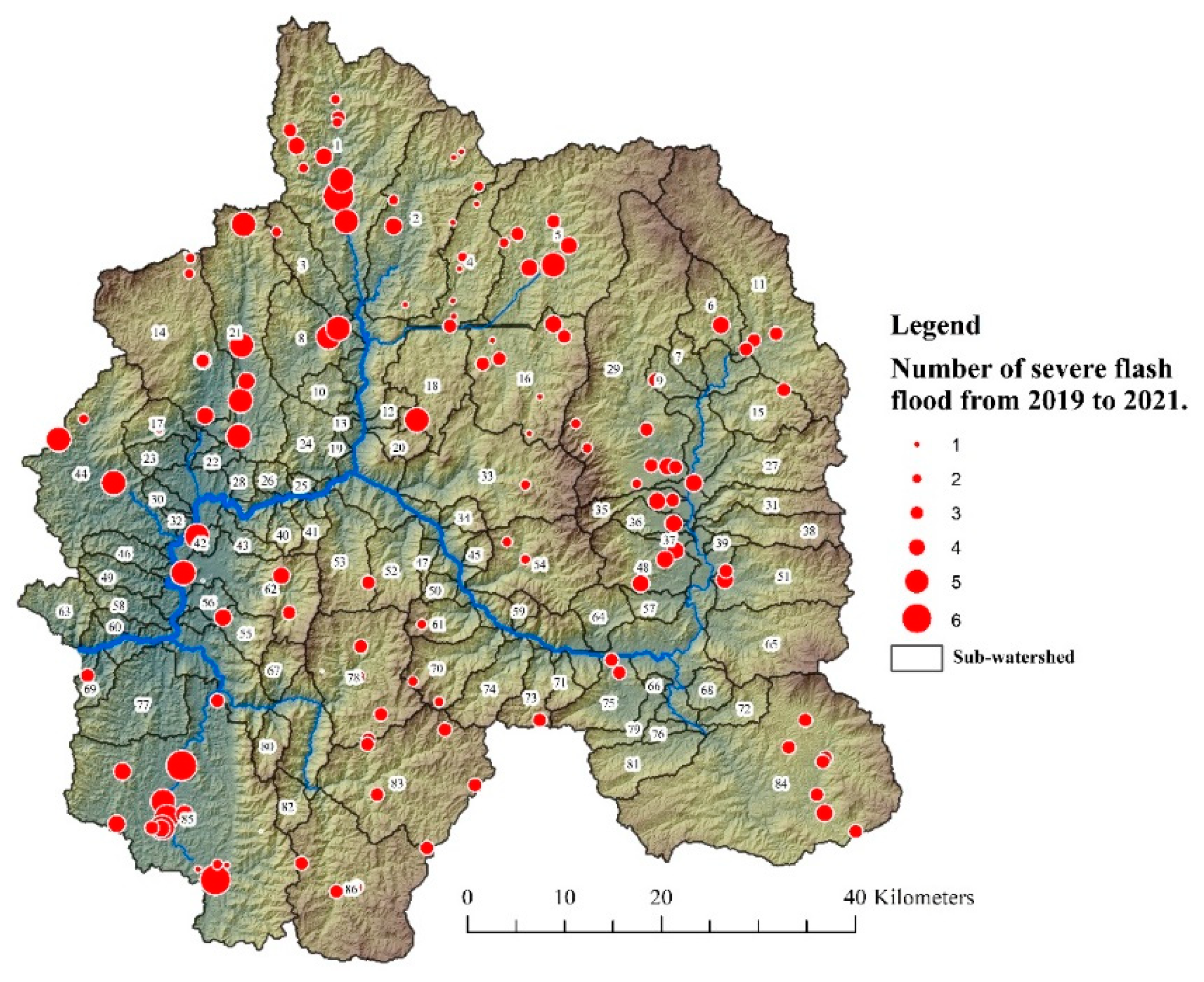
| Category | Morphometric Parameters | Formula/Definition | Reference |
|---|---|---|---|
| basic features | 1. Area of the basin (A) | plan area of the watershed | - |
| 2. Basin perimeter (P) | perimeter of the watershed | - | |
| 3. Basin length (L) | length of watershed | [28] | |
| 4. Stream order (U) | ranking of stream | [28] | |
| 5. Total stream number (Nu) | total no. of streams of all orders in watershed | [28] | |
| 6. Total stream length (Lu) | stream length | [29] | |
| 7. Mainstream length (Lms) | length of the longest channel from a source to the outlet | [30] | |
| 8. Basin slope (Sb) | slope of watershed | [31] | |
| linear features | 9. Bifurcation ratio (Rb) | Rb = Nu/Nu+1 | [32] |
| 10. Stream frequency (Fs) | Fs = Nu/A | [29] | |
| 11. Drainage density (Dd) | Dd = Lu/A | [29] | |
| 12. Length of overland flow (Lo) | Lo = 1/(2 × Dd) | [29] | |
| 13. Infiltration number (If) | If = Fs × Dd | [32] | |
| areal features | 14. Elongation ratio (Re) | [33] | |
| 15. Circularity ratio (Rc) | Rc = 4 × π × A/P2 | [33] | |
| 16. Form factor (Ff) | Ff = A/L2 | [34] | |
| 17. Texture ratio (Rt) | Rt = Nu/P | [35] | |
| 18. Lemniscates ratio (K) | K = L2/(4 × A) | [36] | |
| 19. Compactness (C) | [34] | ||
| relief features | 20. Relief (R) | R = Hmax − Hmin | [33] |
| 21. Relief ratio (Rr) | Rr = R/L | [33] | |
| 22. Ruggedness ratio (Rn) | Rn = R∗Dd | [31] | |
| 23. Relative relief ratio (Rv) | Rv = R/P | [31] |
Publisher’s Note: MDPI stays neutral with regard to jurisdictional claims in published maps and institutional affiliations. |
© 2022 by the author. Licensee MDPI, Basel, Switzerland. This article is an open access article distributed under the terms and conditions of the Creative Commons Attribution (CC BY) license (https://creativecommons.org/licenses/by/4.0/).
Share and Cite
Chaithong, T. Flash Flood Susceptibility Assessment Based on Morphometric Aspects and Hydrological Approaches in the Pai River Basin, Mae Hong Son, Thailand. Water 2022, 14, 3174. https://doi.org/10.3390/w14193174
Chaithong T. Flash Flood Susceptibility Assessment Based on Morphometric Aspects and Hydrological Approaches in the Pai River Basin, Mae Hong Son, Thailand. Water. 2022; 14(19):3174. https://doi.org/10.3390/w14193174
Chicago/Turabian StyleChaithong, Thapthai. 2022. "Flash Flood Susceptibility Assessment Based on Morphometric Aspects and Hydrological Approaches in the Pai River Basin, Mae Hong Son, Thailand" Water 14, no. 19: 3174. https://doi.org/10.3390/w14193174
APA StyleChaithong, T. (2022). Flash Flood Susceptibility Assessment Based on Morphometric Aspects and Hydrological Approaches in the Pai River Basin, Mae Hong Son, Thailand. Water, 14(19), 3174. https://doi.org/10.3390/w14193174






